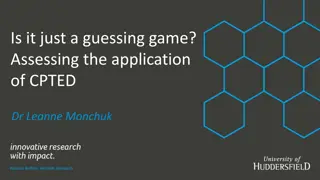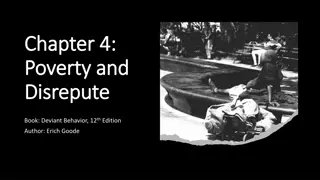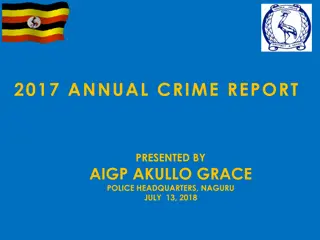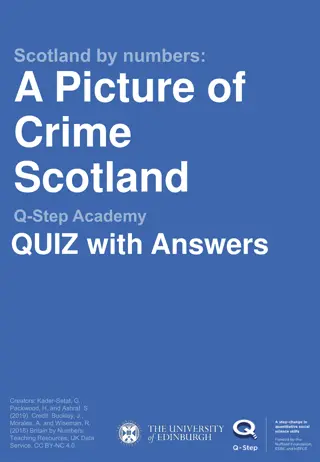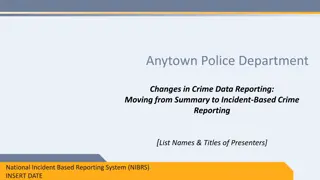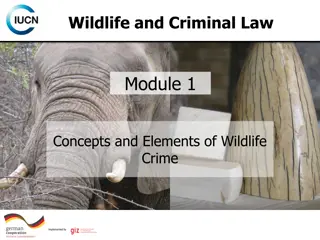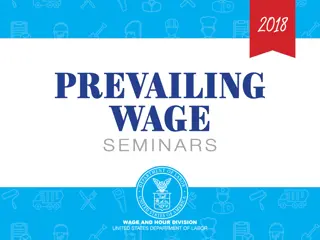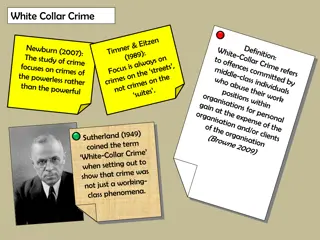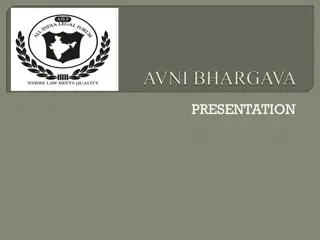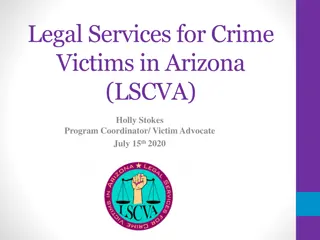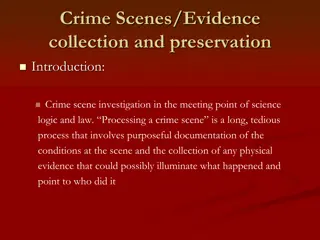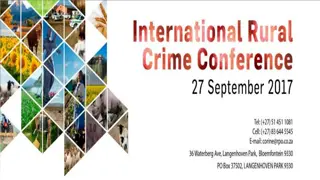The Social Construction of Crime and Deviance
Exploring the concept of deviance as a social construct, this content dives into how society labels certain behaviors, the origins of labeling theory, and the role of media in amplifying deviance. Key concepts include societal reaction, symbolic interactionism, and the work of Howard Becker in shaping our understanding of deviant behavior.
Download Presentation

Please find below an Image/Link to download the presentation.
The content on the website is provided AS IS for your information and personal use only. It may not be sold, licensed, or shared on other websites without obtaining consent from the author.If you encounter any issues during the download, it is possible that the publisher has removed the file from their server.
You are allowed to download the files provided on this website for personal or commercial use, subject to the condition that they are used lawfully. All files are the property of their respective owners.
The content on the website is provided AS IS for your information and personal use only. It may not be sold, licensed, or shared on other websites without obtaining consent from the author.
E N D
Presentation Transcript
The social construction of crime and deviance
What are the questions about? How social reality is constructed in our minds and does not exist externally How society defines certain acts as deviant and acts on these How society can make deviance greater rather than reduce it How deviance is not caused by external social forces, ie)culture/poverty etc
Areas of focus: The origins of labelling theory How society defines what is deviant? (Deviance as a relative concept) Rule creation The Process of labelling (how it happens) The effects of labelling The role of the media (deviance amplification) Methodological issues Evaluation
Concepts you need to know Selective policing Master status Societal reaction Primary/secondary deviance Labels Self concept Self fulfilling prophecy Stigma Sensitisation Deviance amplification Relative deviance Folk devils & moral panics
The origins of this theory Howard Becker and others within the CHICAGO SCHOOL Ethnographic approach How people make sense of social reality The police,courts,media adopt stereotypes and generate societal reaction
Becker had his fingers in a lot of social constructionist pies Most famous book OUTSIDERS (1955) Issues he discusses Rule creation Moral entrepreneurs and crusades Relative deviance Societal reaction Selective policing Deviant careers Master status
Symbolic Interactionism so much to answer for George Herbert Mead Max Weber
Deviance is Relative Not absolute What is deviant depends on the definitions held in that society It is not the act!!! Its all about society s reaction starwarskidlegend
Deviant behaviour is behaviour so labelled Its not the act that s important but how we perceive (define) the act..this is relative Howie B
Who doing the act? Who witnessing the act? Place Deviance is relative Time Culture These change over time .NOT ABSOLUTE!
How positivist/structural and interpretivist/action ideas differ Positivist approach Man is shaped by social forces Reality is external and objective We can measure the causes of crime A minority are driven to deviance Interpretivistic approach Man is shaped by ideas and meanings Reality is internal and subjective We cannot measure the causes of crime Most people engage in deviance
Laws are social constructs Moral entrepreneurs Moral panics Moral crusades squiggle_m BECKER on Rule Creation
Examples of relative deviance/rule creation Marijuana Tax Act 1930s Prohibition 1920s Decriminalisation of homosexuality USA (1974) Decriminalisation of suicide 1960s Children outside marriage (moral imbecility)
The process of labelling Stereotypical criminal/deviant Sensitisation Selective policing Lambert/Sutherland/Becker/ Cicourel/Kalven and Zaesel
Homeworks in chase! Name Subcultural essay Received Received X X X New right essay Saba Linda Lilly Josh Holly S X X X X X
Erving Goffman goffman Presentation of the self Self-concept How others see us affects how we act Stigmatisation attach a negative label Deviant career once labelled Mental illness Career of a marijuana user ASYLUMS STIGMA
Edwin M Lemert Primary deviance sensitisation Societal reaction amplification Secondary deviance
The self concept transforms We absorb the label once labelled The deviance is amplified Notting Hill Hippies Jock Young
The effects of labelling Influences the self-concept looking glass self (Charles Cooley) Self fulfilling prophecy The master status and SFP Primary/secondary deviance
Deviance Amplification How deviance is increased (amplified) through societal reaction Main focus is on role of the MASS MEDIA Can refer to general idea of interaction and increased deviance med003
The implications of the deviance amplification idea Society creates greater levels of deviance The mass media are a problem The mass media are not neutral and they sensationalise The mass media influences public opinion, the role of police, courts and politicians The mass media affects an individual s self concept The individual deviant is not to blame there are no single causes like poverty, socialisation etc
Folk Devils & Moral Panics Media and youth subcultures The media is a vehicle for re-establishing social order The media exaggerates a social problem (moral panic) It identifies a source of the problem (folk devil) It tries to help eliminate the problem Stanley_Cohen Stan Cohen
Deviance amplification cycle Social problem Deviant act Group identified as cause (Folk devil) Proof Media exaggerates (moral panic) Find more cases Police/courts (sensitised) Societal reaction
Stan Cohen Mods and rockers 1964 Newspaper report fights Selective policing More arrests/harsher punishments More young people attracted to it
Other moral panics Black muggings Single parent families Asylum seekers Joy riding ACID and rave culture HIV and AIDS Travellers/Gypsies Jews in Nazi Germany
Consolidation Using material from the previous ppt slides show your understanding of the deviance amplification process. Focus on: Societal reaction/sensitisation Stereotyping/expectations Effects on self-concept of young people How the media amplified deviance The effect of the media on the public, police, politicians and courts The way that subcultures are created and reinforced Use examples from the modern day as well as the Mods and Rockers
Further studies Armstrong and Fishman Glasgow election Fishman New York Muggings Stuart Hall Policing the Crisis
Stuart Hall Policing the Crisis Neo Marxist CCCS Crisis in hegemony Targeted black youth mugging moral panic Sensitisation selective policing Suss laws
Advantages of Labelling Theory It does not treat official statistics as fact It rejects the idea that deviants are different to normal people It questions the effectiveness of policing, the courts and punishment It raises the issue of power It considers the impact of the mass media It highlights the bias in law enforcement It considers societal reaction and the effects on individuals
Disadvantages of Labelling Theory Its over-romantic Too much focus on exotic deviance Ignores the origins of deviant acts There is absolute deviance It uses labelling in a deterministic way More attention needed on the behaviour that produced the label Deviants can adopt identity without being labelled Not explore fully capitalism and economic power
What other theories say Functionalism etc Challenge the idea Absolute deviance set normal standards Media must dramatise and make public deviance to reinforce common values Police and courts are neutral Law making is neutral reflects shared values There are causes of deviance that can be measured
Marxism Share idea of biased laws and selective policing Much overlap in Neo-marxism (New Criminology/CCCS) Traditional Marxism is though more structural and deterministic More attention on the economy (capitalism) needed
Synoptic education Labelling in the classroom SFP Stereotypes in resources affects on self concept Whose curriculum? Who shapes it?
Synoptic links - family Gender socialisation Politics of the family (Laing and mental health) Single parent families Gay households Social construction of childhood and old age
Question. Evaluate the claim that both the nature and extent of deviance is socially constructed



